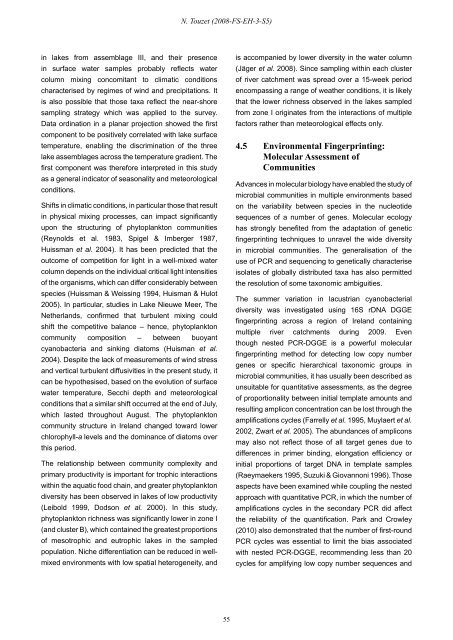STRIVE - Environmental Protection Agency
STRIVE - Environmental Protection Agency
STRIVE - Environmental Protection Agency
You also want an ePaper? Increase the reach of your titles
YUMPU automatically turns print PDFs into web optimized ePapers that Google loves.
in lakes from assemblage III, and their presence<br />
in surface water samples probably reflects water<br />
column mixing concomitant to climatic conditions<br />
characterised by regimes of wind and precipitations. It<br />
is also possible that those taxa reflect the near-shore<br />
sampling strategy which was applied to the survey.<br />
Data ordination in a planar projection showed the first<br />
component to be positively correlated with lake surface<br />
temperature, enabling the discrimination of the three<br />
lake assemblages across the temperature gradient. The<br />
first component was therefore interpreted in this study<br />
as a general indicator of seasonality and meteorological<br />
conditions.<br />
Shifts in climatic conditions, in particular those that result<br />
in physical mixing processes, can impact significantly<br />
upon the structuring of phytoplankton communities<br />
(Reynolds et al. 1983, Spigel & Imberger 1987,<br />
Huissman et al. 2004). It has been predicted that the<br />
outcome of competition for light in a well-mixed water<br />
column depends on the individual critical light intensities<br />
of the organisms, which can differ considerably between<br />
species (Huissman & Weissing 1994, Huisman & Hulot<br />
2005). In particular, studies in Lake Nieuwe Meer, The<br />
Netherlands, confirmed that turbulent mixing could<br />
shift the competitive balance – hence, phytoplankton<br />
community composition – between buoyant<br />
cyanobacteria and sinking diatoms (Huisman et al.<br />
2004). Despite the lack of measurements of wind stress<br />
and vertical turbulent diffusivities in the present study, it<br />
can be hypothesised, based on the evolution of surface<br />
water temperature, Secchi depth and meteorological<br />
conditions that a similar shift occurred at the end of July,<br />
which lasted throughout August. The phytoplankton<br />
community structure in Ireland changed toward lower<br />
chlorophyll-a levels and the dominance of diatoms over<br />
this period.<br />
The relationship between community complexity and<br />
primary productivity is important for trophic interactions<br />
within the aquatic food chain, and greater phytoplankton<br />
diversity has been observed in lakes of low productivity<br />
(Leibold 1999, Dodson et al. 2000). In this study,<br />
phytoplankton richness was significantly lower in zone I<br />
(and cluster B), which contained the greatest proportions<br />
of mesotrophic and eutrophic lakes in the sampled<br />
population. Niche differentiation can be reduced in wellmixed<br />
environments with low spatial heterogeneity, and<br />
N. Touzet (2008-FS-EH-3-S5)<br />
55<br />
is accompanied by lower diversity in the water column<br />
(Jäger et al. 2008). Since sampling within each cluster<br />
of river catchment was spread over a 15-week period<br />
encompassing a range of weather conditions, it is likely<br />
that the lower richness observed in the lakes sampled<br />
from zone I originates from the interactions of multiple<br />
factors rather than meteorological effects only.<br />
4.5 <strong>Environmental</strong> Fingerprinting:<br />
Molecular Assessment of<br />
Communities<br />
Advances in molecular biology have enabled the study of<br />
microbial communities in multiple environments based<br />
on the variability between species in the nucleotide<br />
sequences of a number of genes. Molecular ecology<br />
has strongly benefited from the adaptation of genetic<br />
fingerprinting techniques to unravel the wide diversity<br />
in microbial communities. The generalisation of the<br />
use of PCR and sequencing to genetically characterise<br />
isolates of globally distributed taxa has also permitted<br />
the resolution of some taxonomic ambiguities.<br />
The summer variation in lacustrian cyanobacterial<br />
diversity was investigated using 16S rDNA DGGE<br />
fingerprinting across a region of Ireland containing<br />
multiple river catchments during 2009. Even<br />
though nested PCR-DGGE is a powerful molecular<br />
fingerprinting method for detecting low copy number<br />
genes or specific hierarchical taxonomic groups in<br />
microbial communities, it has usually been described as<br />
unsuitable for quantitative assessments, as the degree<br />
of proportionality between initial template amounts and<br />
resulting amplicon concentration can be lost through the<br />
amplifications cycles (Farrelly et al. 1995, Muylaert et al.<br />
2002, Zwart et al. 2005). The abundances of amplicons<br />
may also not reflect those of all target genes due to<br />
differences in primer binding, elongation efficiency or<br />
initial proportions of target DNA in template samples<br />
(Raeymaekers 1995, Suzuki & Giovannoni 1996). Those<br />
aspects have been examined while coupling the nested<br />
approach with quantitative PCR, in which the number of<br />
amplifications cycles in the secondary PCR did affect<br />
the reliability of the quantification. Park and Crowley<br />
(2010) also demonstrated that the number of first-round<br />
PCR cycles was essential to limit the bias associated<br />
with nested PCR-DGGE, recommending less than 20<br />
cycles for amplifying low copy number sequences and

















